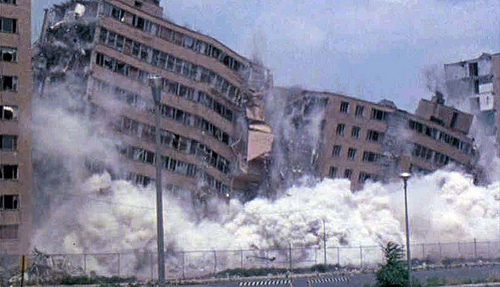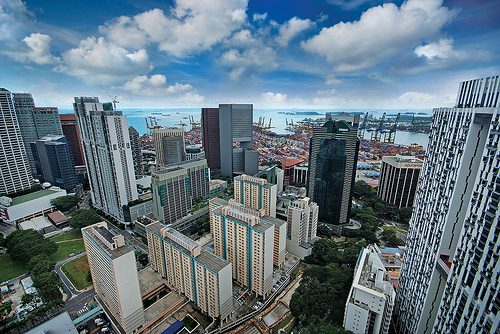
Pruitt-Igoe in St. Louis. Photo by Michael R. Allen, CC BY-NC
For a while I have been meaning to write about the January piece in The New York Times, “Towers of Dreams: One Ended in Nightmare,” which contrasts the failure of the Pruitt-Igoe public housing project in St. Louis (recently the subject of a documentary) and successful “tower in the park” projects, such as the Penn-South housing cooperative in Manhattan.
Of course, there are plenty of examples of successful high rise apartment and condominium projects all over the country, from apartment buildings along 16th Street or Connecticut Avenue in DC, to the exclusive condominium buildings on Lake Michigan in Chicago or high-end housing in Manhattan, and comparable housing in those and other cities around the country.
In short, successful housing isn’t merely a function of its form—design is not destiny—it’s also a function the economic and social mix present within the communities.
We call this “demographics”, but what if the “demographics” of the tenants aren’t favorable to the development of strong public housing communities? Do we take that for granted, or do we work to build the systems and programs, what we might call the “social infrastructure,” that might be needed to seed and build community?
Neal Peirce has a column, “A Nation of Public Housing,”about public housing in Singapore. Singapore, known for strong social control systems and social engineering (you go to jail for littering, etc.) extends this to their public housing programs. Most housing in the city-state is publicy provided. There are strict guidelines for getting in—you have to have a job and be married (unless you’re 35 years or older).
The housing is well designed, but its all towers, given the city’s population density. From the article:
Singapore is redefining public housing design in a dramatic fashion. Standing at ground level, one gasps with amazement at the height and drama of the new Pinnacle housing project, opened in 2009 on a prime center-city piece of land.
And why? Soaring upward from ground level are no less than seven 50-story apartment towers. And “not just towers”—the seven as actually linked, made a single community and project, because they’re connected by skybridges. One, on the 26th floor, offers residents a children’s playground, an outdoor gym, and a quite amazing 800-meter long jogging track. And on the 50th floor, there’s a sky garden and 360-degree viewing deck.
It’s in the nature of high-rises to be far more impersonal than communities of more human scale. But of one plans high-rises with care—social as well as physical—the results can be highly positive. And as the world—Asia a prime example—adds billions more people, attractive and livable high rises can make a dramatic difference.
There are a variety of unit sizes, and the cost is about 20 percent of household income, and people can “move up” to larger units or different communities as their households and lives change. Singapore also subsidizes social clubs of all types, and these programs are also present within public housing projects.
The public housing program also confers to the tenant a kind of ownership interest in the apartment that can be sold, which helps build not only the “sense of ownership” that is the heart of US housing policy for owner-occupied housing but financial equity and household wealth.
While public safety systems and penalties reduce the kind of vandalism and decline often associated with public housing in the United States and in Europe, the ability to generate a type of ownership equity (not unlike how “rent to own” programs are used to sell properties in weak real estate markets) means that renters are incentivized to take good care both of their units and their social housing community more generally.
Getting back to the Times article, which was taken by people as a defense of modernism, as the writer made the point that the issue with Pruitt-Igoe wasn’t modernism per se, but how the project was conceived and executed. From the article:
Like Pruitt-Igoe, Penn South was a midcentury slum-clearance project. Designed by Herman Jessor as a modern cooperative for working class families, backed by the International Ladies Garment Workers Union, it called for 10 buildings spread across 20 acres between Eighth and Ninth Avenues, from 23rd Street to 29th Street. It was not public housing. Two bedroom apartments cost $3,000 when the complex opened in 1962. (Those same apartments now sell for $100,000.) President John F. Kennedy stood atop a flag-decked dais in the bright May sun to dedicate it.
Steady income from maintenance payments and retail units in commercial buildings the co-op owned guaranteed Penn South a stable income. Tax relief from the city shielded it from escalating real estate values. Residents poured money into improvements. Repeatedly they declined the right to sell their apartments at market rates, preserving the ideal of moderate-income dwellings, adding facilities for toddlers and the elderly, playgrounds, a community garden and a ceramics studio.
But he glosses over the “ownership” piece, although he does make the point that the federal housing program was restricted in its ability to develop complete communities in the face of opposition by anti-housing forces nationally and locally, and that by comparison Penn-South is owner occupied and run as a cooperative venture by the tenants while Pruitt-Igoe was managed by outsiders (in this case the local housing authority) as “public housing.”
So the Penn-South cooperative used the revenues from the project to reinvest in community-oriented improvements, such as playgrounds, while public housing developments typically don’t have that option.
Note also that the point about inclusion of retail is important. This typically is considered illegal as part of federally-supported housing projects, which I think is a mistake. If retail can be sustained as part of a project it should be included, not unlike the little shopping center at the heart of Old Greenbelt in Maryland. After all, as Professor Alex Wall says “commerce is the engine of urbanism.” In Penn-South and Greenbelt, retail spaces also generate revenue that supports other civic and community priorities and investments.
While form is important, e.g., the “lessons” learned by Oscar Newman in what he called “Defensible Spaces,” I think that the real lesson is that the importance of form is not merely about the physical, but extends to “soft” form issues and includes social, economic, and programmatic elements of form as well.
Without attention to all the elements that construct positive community, negative community can be generated just as easily, generating havoc and deterioration.
Lessons
-
- Commit to the creation of high quality housing that lasts as opposed to value-engineered construction that doesn’t last (the money might not be there for rebuilding when the time comes…);
- Inclusion of civic amenities (playgrounds, etc.) built into the project to build complete communities;
- Complementary social and community support and development programs;
- Provision of a variety of housing sizes and places to live;
- Elements of ownership: tenant has equity position/ownership interest in the property which can be sold/transferred, and contributes to the household wealth portfolio;
- Depending on the location of the project, integration of retail and other commercial spaces.







Comments